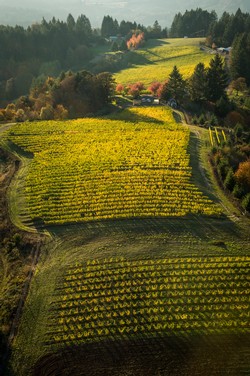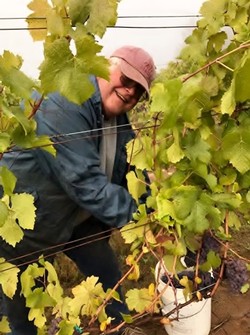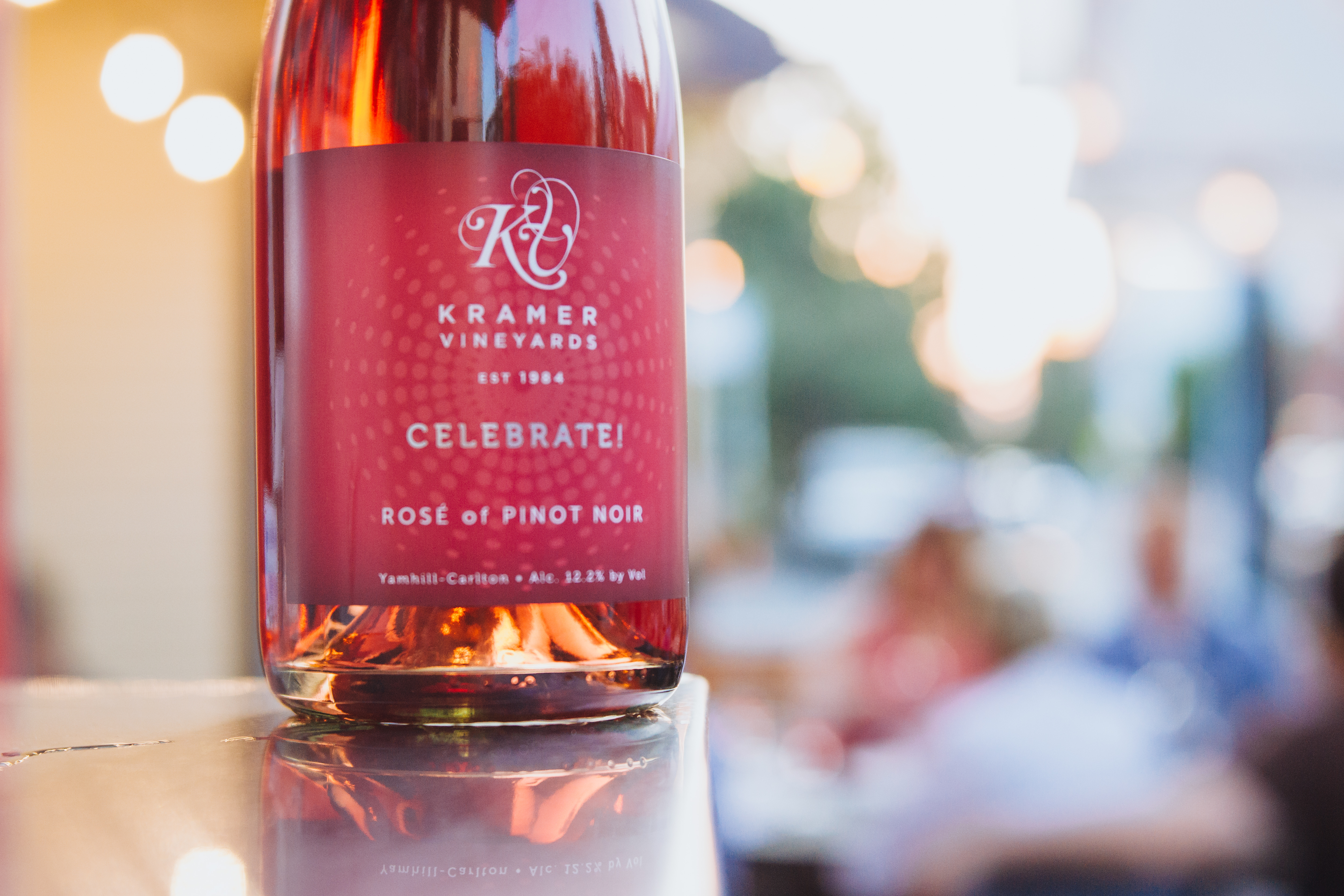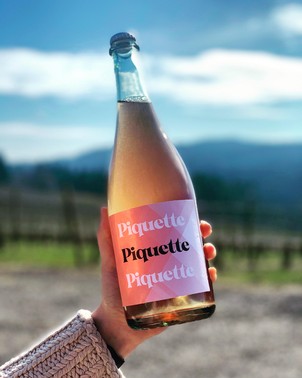🍇 Kramer Vineyards Blog: Discover Wine Tips, Stories, and More 🍷
Welcome to the Kramer Vineyards blog, your go-to resource for all things wine! From expert pairing tips and behind-the-scenes vineyard stories to seasonal inspiration, discover the artistry, history, and passion behind every bottle. Explore our latest articles and uncover new ways to enjoy exceptional wines.
Never Miss a Story!
Subscribe to the Kramer Vineyards newsletter for the latest wine tips, pairings, and stories.
The Art of Sparkling Wine: Storage, Opening, Serving, and Stemware - Kramer Style!
Mastering the Art of Oregon Sparkling Wine
Welcome to the world of Oregon sparkling wine, where proper storage, opening, serving, and stemware selection are key to preserving the integrity and enhancing the experience of each effervescent sip. At Kramer Vineyards in the north Willamette Valley, we take great pride in sharing our expertise on these essential aspects. Join us as we unlock the secrets of Kramer Vineyard's sparkling wines and discover the unique character that Oregon brings to the world of bubbles. In this blog post, we'll explore the art of storage, graceful bottle opening, impeccable serving techniques, and stemware that elevates the enjoyment of our Oregon sparkling creations.
Proper Storage: Nurturing the Effervescence of Oregon's Sparkling Wines
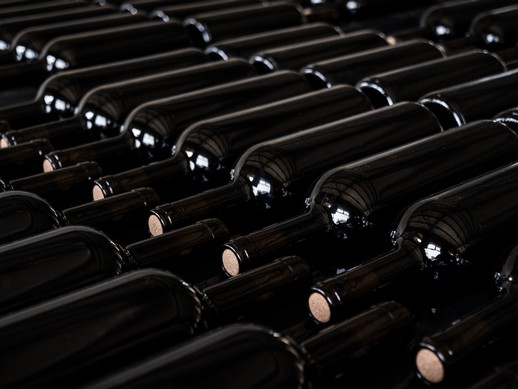
Creating the Ideal Environment
To properly store your bottles of Oregon sparkling wine, creating an ideal environment that allows them to age gracefully and preserve their vibrant flavors is crucial. Consider the following factors:
- Temperature and Humidity Control: For long-term storage, maintain a consistent and cool temperature between 45°F (7°C) and 55°F (13°C) to prevent fluctuations that could affect the wine's flavor and effervescence. Aim for a humidity level between 50% and 80% to avoid cork drying or excessive moisture.
- Minimizing Light Exposure: Protect your bottles from UV light, which can cause undesirable flavors. Store them in a dark or dimly lit area, such as a wine cellar or a cabinet with opaque doors.
- Allowing Bubbles to Evolve and Mature: Store the bottles horizontally to keep the cork moist and prevent it from drying out. This position ensures a proper seal and preserves the wine's effervescence as the bubbles gradually evolve, adding complexity to the wine over time.
Graceful Bottle Opening: Celebrating Oregon's Sparkling Wine
Mastering the Technique of Opening Sparkling Wine
Opening a bottle of Oregon sparkling wine is an art that adds to the anticipation and enjoyment of the moment. Follow these steps to open your sparkling wine like a pro:
- Remove the foil or wire cage gently, keeping your thumb on top of the cork.
- Wrap a tea towel around the cork and the top of the bottle to better grip and prevent the cork from flying unexpectedly.
- Hold the bottle at a slight angle, pointing away from yourself and others.
- Firmly grip the towel-covered cork and twist the bottle (not the cork) to gradually release the pressure, creating a soft and elegant pop.
By incorporating the tea towel, you can enhance your grip on the bottle, especially if it has become slippery due to being in an ice bath or condensation. This extra precaution ensures a controlled and safe opening, allowing you to enjoy the experience of opening an Oregon sparkling wine bottle.
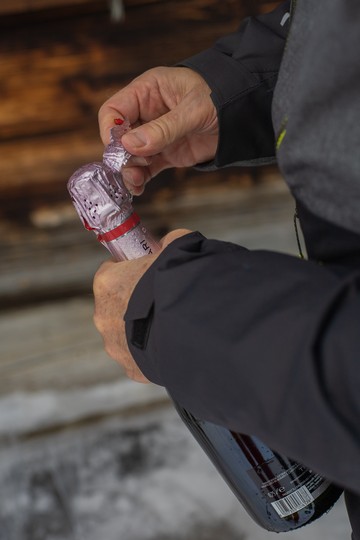
Unveiling Unique Character
As the cork is released, the aromas and flavors of our Oregon sparkling wine come to life. Take a moment to appreciate the effervescent bubbles dancing in the glass, indicating the wine's exceptional quality. The initial burst of bubbles reveals the wine's freshness and liveliness, creating a captivating visual display.
Just like still wines, sparkling wines transform as they warm slightly and have some air contact in the glass. This evolution can be a fascinating journey as the wine's aromas and flavors develop and unfold.
Savor each sip and allow the wine to evolve in the glass. Notice how the aromas become more pronounced, the flavors more nuanced, and the texture more expressive. Initially energetic and effervescent, the bubbles may mellow slightly over time, revealing a more delicate and refined effervescence.
Each glass offers a unique glimpse into the wine's character, showcasing the meticulous craftsmanship and the distinct terroir of Kramer Vineyard. Embrace the evolving nature of the wine as it warms and breathes in the glass, allowing it to reveal its true depth and complexity.
By taking the time to appreciate the wine's evolution in the glass, you can fully immerse yourself in the captivating experience of our Oregon sparkling wines and discover the intricate layers that make them truly special.
Impeccable Serving Techniques: Enhancing the Oregon Sparkling Experience
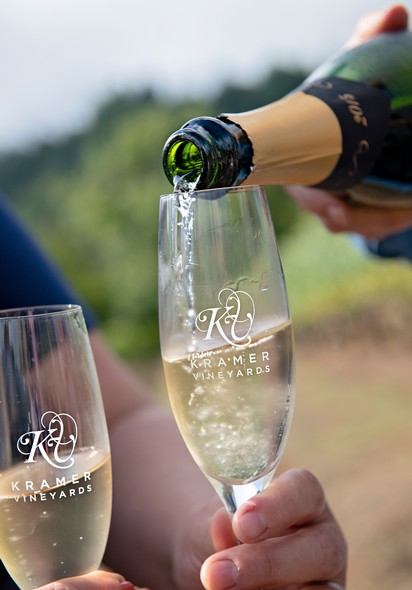
Finding the Ideal Serving Temperature
Serving our Oregon sparkling wines at the right temperature is crucial to fully appreciating their flavors, aromas, and effervescence. Ensuring the bottle is chilled to the optimal temperature can enhance the tasting experience and unlock the wine's true potential.
To bring out the best in most sparkling wines, we recommend serving them at a temperature between 41°F (5°C) and 45°F (7°C). This range helps preserve the bottle's effervescence and showcases the wine's fresh citrus notes and lively acidity. It's a great serving temperature that allows the wine to express its vibrant character.
For vintage Champagnes and extended tirage sparkling wines, you can slightly adjust the serving temperature to around 45°F to 50°F (7°C to 10°C). This subtle increase in temperature can enhance the development of toast and biscuit notes, adding complexity to these special wines.
While it's important to consider these recommendations, serving temperature is a personal preference, and you may find slight variations that suit your taste. The key is to avoid over-chilling, as excessively low temperatures can diminish the flavors and nuances of the wine. If your bottle feels too cold, allow it to rest at room temperature for a few minutes to gently warm up before serving.
By serving our Oregon sparkling wines at the recommended temperatures, you can fully appreciate their vibrant flavors, delightful aromas, and effervescent charm, ensuring a gratifying and memorable tasting experience.
Selecting Appropriate Stemware
The selection of stemware for sparkling wines is highly personal and often sentimental. Our recommendations aim to enhance the enjoyment of our Oregon sparkling wines, but ultimately, you should use the stemware that brings you the most joy, whether it be a coupe, flute, glass, or tumbler. The shape of the glass can influence the release of aromas, the display of bubbles, and the overall tasting experience. Here are some recommendations for different types of sparkling wines:
- For Pét-Nat & Celebrate wines, Prosecco, or Sekt: Flute
We recommend using flute glasses for our Celebrate and sparkling wines like Prosecco or Sekt. The slender and narrow flute shape helps maintain the effervescence and makes the bubbles last longer. It also creates an elegant and visually captivating experience, perfect for celebrating special moments. - For Traditional sparkling wines: Flute or Riedel Oregon Pinot Glass
For our traditional method sparkling wines, you have a couple of options. Flute glasses, with their slender shape, can preserve the effervescence and showcase the wine's lively bubbles. Alternatively, you can also use the Riedel Oregon Pinot Noir glass with a larger bowl. The broader bowl of this glass allows the bubbles to unfurl and develop, providing more space for the wine's aromas to evolve. - Vintage champagnes or extended tirage sparkling wines: Riedel Champagne glasses or the Riedel Oregon Pinot Glass
It's best to use glasses that can fully express their complexity for special wines like vintage champagnes or extended tirage sparkling wines. Riedel Champagne glasses, designed specifically for sparkling wines, provide the perfect shape to capture the wine's aromas and allow them to develop. Alternatively, you can also use the Riedel Oregon Pinot Noir glass, which offers a larger bowl to enhance the wine's aromatics and the expression of its unique character.
Choosing the right stemware enhances the visual appeal and allows you to fully experience our Oregon sparkling wines' aromas, flavors, and effervescence. Enjoy the captivating dance of bubbles and savor every sip in the glass that complements your chosen wine.
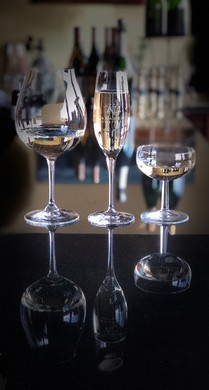
The Gentle Pour
A gentle and steady approach preserves the effervescence when pouring our Oregon sparkling wines. Tilt the glass at a slight angle and pour the wine slowly down the side of the glass, allowing it to cascade gently. This technique minimizes agitation, preserving the bubbles and preventing excessive foaming. When finished serving, seal the bottle with a sparkling stopper to hold the pressure for your next glass.
In the picturesque Willamette Valley, Kramer Vineyards proudly crafts exquisite Oregon sparkling wines that captivate the senses and reflect the region's unique terroir. By mastering the art of storage, opening, serving, and selecting the right stemware, you can unlock the full potential of our Méthode Champenoise creations. Ready to embark on your sparkling wine journey with Kramer Vineyards? Explore our exquisite selection of Oregon sparkling wines and experience the magic of bubbles in every sip. Visit our sparkling wine collection to discover our wines' exceptional craftsmanship and unique character. Cheers to living your best sparkling life the Kramer way!
Share this post:
The Art of Dosage: Transforming Sparkling Wines with a Delicate Touch
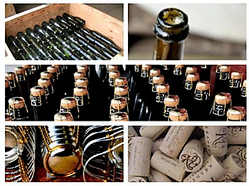 Have you ever wondered what dosage means in champagne and sparkling wine? Allow us to shed some light on this vital aspect of the winemaking process.
Have you ever wondered what dosage means in champagne and sparkling wine? Allow us to shed some light on this vital aspect of the winemaking process.
Dosage refers to the addition of a finishing syrup after the second fermentation in the bottle. This step involves carefully introducing small amounts of sugar to the wine. The purpose of dosage is multi-fold: it helps to balance the naturally high acidity of the wine, accentuates its fruit flavors, contributes to a smoother texture, and so much more.
We highly recommend reading this interview with noted Champagne expert Peter Liem by wine writer Jaime Goode for a comprehensive and insightful read on dosage, grower-producers, and viticulture. It provides a holistic understanding of the role of dosage in creating exceptional sparkling wines.
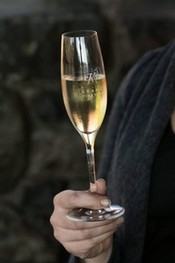 In our cellar, we eagerly anticipate the moment we get to taste our sparkling wines shortly after bottling. The wine is dry, effervescent, and alive with suspended yeast cells at this stage. It never fails to be a thrilling experience.
In our cellar, we eagerly anticipate the moment we get to taste our sparkling wines shortly after bottling. The wine is dry, effervescent, and alive with suspended yeast cells at this stage. It never fails to be a thrilling experience.
Once the second fermentation is complete, we carefully evaluate the need for dosage. We prepare a range of wines with varying sugar levels, up to 10 grams per liter. Throughout our winemaking history, we have bottled sparkling wines with dosages ranging from 3 to 8 grams per liter. However, we must admit that we also have a soft spot for crisp, tart, and bone-dry wines that don't require any additional dosage.
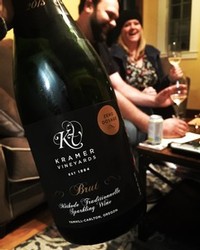
As a sparkling winemaker, my perspective on dosage has evolved significantly. When younger and less experienced, I preferred the romance of a perfect, raw sparkling wine without dosage. I have since learned that when the dosage is employed judiciously, it can elevate a wine and bring out its true essence in a way that remains authentic to the terroir and vintage (while leaving room for zero-dosage wines when that's the best expression of these qualities).
While the movement towards lower or zero dosage has gained traction over the last two decades, particularly among grower-producers emphasizing terroir expression, I have come to appreciate the transformative potential of dosage when used thoughtfully and in harmony with the wine's character.
Today, I invite you to join me in a deeper exploration of dosage's intricate role in champagne and sparkling wine. Let us take a moment to cherish how dosage contributes to the delightful flavors, textures, and nuances that unfold in every glass. If you are intrigued to experience the range of our sparkling wines, please visit our website or contact us for more information.
Together, let's toast the exquisite art of dosage and celebrate the wondrous journey of Kramer sparkling wines. Cheers to the magic that unfolds in each bottle!
Five Fizzy Facts About our Celebrate Bubbly
Are you a fan of sparkling wines? If so, you're in luck because Kramer Vineyards produces some of the best Oregon sparkling wines! Here are five fizzy facts that make our wines stand out:
The Kramer estate vineyard.
100% varietal wines
Our Celebrate sparkling wines are unique varietal wines, including Pinot Noir, Grüner Veltliner, Pinot Gris, and Müller-Thurgau. We believe that each grape's flavor is best showcased on its own. The effervescence of our Celebrate wines only enhances the natural flavors and aromas of these varietals, resulting in a refreshing and perfect sparkling wine for any occasion.
Handcrafted in small batches
Due to the size of our vineyard and winery, we've always taken a small-batch approach to winemaking. With only 22 acres of estate vines and 27 individual blocks, we carefully track and evaluate each block to ensure the fruit is of the highest quality for wines of this style. This approach means we're always working with tiny lots, allowing us to pay close attention to each batch and ensure that our wines are of the highest quality.
Fresh and lively
Our Celebrate sparkling wines are not aged for extended periods like traditional method sparkling wines. Instead, we use a modern proprietary method to release the wines only a few months after harvest. This preserves the fresh, lively character of the grapes and results in a wine bursting with flavor.
Tiny bubbles
Most force-carbonated sparkling wines are injected with carbon dioxide on the bottling line, producing coarse, soda-pop-like bubbles. We believed a smaller bubble was possible with force carbonation. In 2004, owner Keith Kramer developed the system we use today. A week before bottling, the wine is transferred into a custom-built tank for pressurization. We chill the wine while gradually raising the pressure, resulting in tiny, plentiful bubbles. Our Celebrate sparkling wines are unique, high quality, and available at a lower price point than traditional sparkling wines due to the abbreviated aging process.
Sustainable winemaking
We prioritize sustainable winemaking practices to minimize our environmental impact at Kramer Vineyards. Our vineyard is dry-farmed, meaning we rely solely on natural rainfall to irrigate our vines, reducing water usage. Additionally, we use a lighter glass bottle for our Celebrate sparkling wines, which has a lower carbon footprint than traditionally made sparkling wines. From using solar panels to power our winery to implementing water conservation techniques, we're committed to preserving the beautiful Oregon wine country for generations.
Kramer Vineyards produces some of the finest Oregon sparkling wines, and we're proud to share them with you. From our 100% varietal wines to our small-batch, handcrafted approach to winemaking, we strive to create wines of exceptional quality and character. We invite you to visit our tasting room and experience our sparkling wines for yourself. Our knowledgeable staff will guide you through a tasting and share our passion for sustainable winemaking. Take advantage of this opportunity to discover some of the best sparkling wines in Oregon. Come and see us today!
Celebrate Rosé of Pinot Noir
Meet Piquette: Wine Just Got Cooler
Discover the Delights of Piquette: A Refreshing, Sustainable Alternative
Piquette is a unique and refreshing drink that offers a delightful alternative to traditional wines. Crafted from pressed grape skins, Piquette is a lower-alcohol, lightly sparkling beverage with a vibrant flavor profile. At Kramer Vineyards, we have embraced this age-old winemaking technique to create a fizzy and refreshing drink that showcases our commitment to sustainability and innovation.
Crafting Piquette: The Art of Repurposing Grape Skins
To create our Piquette, we repurpose the grape skins that remain after the juice extraction process. These grape skins are rehydrated, allowing the release of sugars and flavors. After steeping for four days, the mixture undergoes gentle pressing, resulting in a beautiful rosy hue. The must is then fermented in stainless steel tanks, creating the delightful effervescence that characterizes Piquette.
"I saw a creative challenge in capturing so many trends with Piquette. It is the intersection of rosé, sparkling, low sugar, lower alcohol, single-serving packaging—and it's adjacent to the cider, craft beer, and hard seltzer categories." said second-generation winemaker Kim Kramer.
Tasting Notes: A Symphony of Flavors
Our Piquette delights the palate with a harmonious blend of flavors. Experience the compelling notes of pomegranate, cran-raspberry, rhubarb, and tart apple, complemented by subtle hints of earth and spice. Each sip of Piquette is a refreshing and vibrant journey, offering a unique taste experience unlike traditional wines.
Enjoying Piquette: Versatile and Refreshing
Piquette is a versatile beverage that can be enjoyed in various ways. Serve it chilled for a refreshing pick-me-up, or mix it into your favorite spritzer or sangria recipes for a flavor twist. It pairs wonderfully with light, summery foods like seafood, salads, grilled vegetables, or light appetizers. With its lower alcohol content, Piquette is perfect for daytime events or as a lighter alternative to wine.
Join the Piquette Revival: Embrace Sustainability and Refreshment
Be part of the Piquette revival and experience the joy of this unique and sustainable beverage. Whether planning a picnic, a leisurely day outdoors, or a social gathering, Piquette is the perfect companion. Celebrate the essence of vineyard life with this refreshing and easy-to-drink option that captures the spirit of innovation and sustainability.
Experience Piquette at Kramer Vineyards
Kramer Vineyards invites you to explore the delights of Piquette. Join us in embracing this ancient winemaking practice, reimagined for modern tastes. Visit our vineyard and savor the vibrant flavors of Piquette. This refreshing beverage embodies our commitment to sustainability and craftsmanship.
Explore our sparkling collection, including Piquette --->>>
Note: To learn more about the emerging trend of lower-alcohol Piquette in Oregon, we recommend reading "Is lower-alcohol Piquette Oregon's next big wine craze?".
Kramer Vineyards: Crafting Unique and Refreshing Beverages Since 1990
Kramer Vineyards is a family-owned and operated winery in its second generation. For nearly 40 years, they have been growing grapes at their sustainably farmed vineyard in the Yamhill-Carlton AVA. Kramer specializes in producing cool climate white, red, and sparkling wines at their property in Gaston, 30 miles west of Portland.
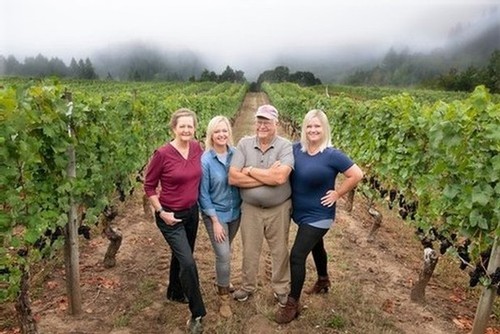
A Big One for Sparkling Wines
Kramer Vineyards harvest larger than ever before
Kramer Vineyards celebrates its largest harvest in 30 years with a record-breaking offering of sparkling wine. Winemaker Kim Kramer's passion for sparkling wines, known for their precision, brings delight to wine lovers. To further celebrate, the family-owned winery will offer 14 sparkling wine releases.
 “We’ve always loved sparkling wines. They are extremely challenging to make because they’re wines of such precision,” said Winemaker Kim Kramer, who’s been producing sparkling wines since the early 2000s. “It’s rewarding to see the delight these wines bring to people’s faces and to see them return for more.”
“We’ve always loved sparkling wines. They are extremely challenging to make because they’re wines of such precision,” said Winemaker Kim Kramer, who’s been producing sparkling wines since the early 2000s. “It’s rewarding to see the delight these wines bring to people’s faces and to see them return for more.”
Dedicated to sharing the delight of its fizzy wines while quenching the thirst of a growing sparkling wine demographic, Kramer started its own sparkling wine club.
Kramer Vineyards is releasing a new collection of traditional method sparkling wines from its estate vineyard in the Yamhill-Carlton AVA to celebrate the bounty of the harvest. These wines are all bottle fermented and composed of Pinot Noir, Chardonnay, and/or Pinot Meunier. This traditional sparkling collection includes vintage and nonvintage Brut, NV Brut Reserve, NV Brut Blanc de Blancs, NV Brut Blanc de Noirs, and NV Brut Rose. Kramer has been experimenting with extended tirage sparkling wines, so expect to see those releases.
If you want more information about this topic, please get in touch with Kim Kramer at (503) 662-4545 or email at kim@kramervineyards.com.
Vintage vs Nonvintage in Sparkling Wines
Explore the distinction between vintage and nonvintage sparkling wines. Vintage wines reflect a specific grape harvest year, while nonvintage blends combine grapes from multiple years. In the US, wines labeled with a vintage year consist of 95% grapes from that year. Nonvintage wines, including those from Champagne, showcase the expertise of blending specialists who artfully combine base wines from different years to create a consistent house style.
At Kramer Vineyards, we have a unique approach to our sparkling wines. Our two nonvintage wines are estate-grown, showcasing the expression of our vineyard site. The composition of these wines varies, with each vintage offering its own character and style.
Notably, our Brut Reserve base wines undergo fermentation and aging in neutral French oak barrels, resulting in added richness, palate weight, and structure compared to stainless steel aging. Meanwhile, our 2015 vintage Brut stands as a wine of both place and time, benefiting from that year's warm and balanced fruit. With an increased proportion of Pinot Meunier in the blend, this vintage exhibits enhanced midpalate presence and fruity aromas. The fruit for this wine is sourced from dedicated blocks within our vineyard, and the blend is carefully determined based on the yields at harvest.
The nonvintage wines in the glass present a fine, delicate mousse with pronounced yeastiness and a focus on tree fruit flavors. On the other hand, the vintage wines captivate with their fresh, light nature, featuring a delicate and abundant bead and showcasing minerality and citrus notes. As these young wines evolve in the bottle, their tone and texture will transform, making it a thrilling journey to witness their progress.
Discover the nuances between vintage and nonvintage sparkling wines, the art of blending and the expression of our vineyard site, through the exceptional offerings from Kramer Vineyards.
Shop Kramer Sparkling Wines
Harvest 2017 Begins
 Although most of vintage 2017 has been warm and dry, the season had a bit of a delayed start. We had budbreak in late April, about two weeks behind average for our site. April showers continued well into May, so when the sun finally came out, the canopy filled in quickly. The vineyard reached 50% bloom on June 24. This is a significant milestone, as harvest for the Pinot Noir will occur about 110 days from that stage, around October 12. Once summer weather arrived in mid-June, we racked up the growing degree days, catching up with 2016 by August. The next growth stage, 50% Veraison, occurred on August 28, supporting our estimate of an October 12 harvest date.
Although most of vintage 2017 has been warm and dry, the season had a bit of a delayed start. We had budbreak in late April, about two weeks behind average for our site. April showers continued well into May, so when the sun finally came out, the canopy filled in quickly. The vineyard reached 50% bloom on June 24. This is a significant milestone, as harvest for the Pinot Noir will occur about 110 days from that stage, around October 12. Once summer weather arrived in mid-June, we racked up the growing degree days, catching up with 2016 by August. The next growth stage, 50% Veraison, occurred on August 28, supporting our estimate of an October 12 harvest date.
Grapes for sparkling wines are harvested a bit earlier to capture the naturally higher acidity. For these wines, we are looking for sugar levels in the 18-20 Brix range, compared to 21-24 Brix for the table wines. The photo above is from our first round of sampling and testing the sparkling varieties for ripeness on September 6.
 Our sparkling harvest began on September 15, with the Pinot Meunier (the image to the right is of the Pinot Meunier harvest) and the Muscat. The Chardonnay and Pinot Noir were picked on September 17, followed by Pinot Blanc on September 24. We also received fruit from vineyards in Banks, Dundee, Gaston and Yamhill.
Our sparkling harvest began on September 15, with the Pinot Meunier (the image to the right is of the Pinot Meunier harvest) and the Muscat. The Chardonnay and Pinot Noir were picked on September 17, followed by Pinot Blanc on September 24. We also received fruit from vineyards in Banks, Dundee, Gaston and Yamhill.
Traditional sparkling enthusiasts can look forward to Brut, Blanc de Noirs, Blanc de Blancs, and Brut Rosé from this vintage, and some zero dosage bottlings of these cuvees. For the Celebrate collection, those grapes are still hanging on the vine…
